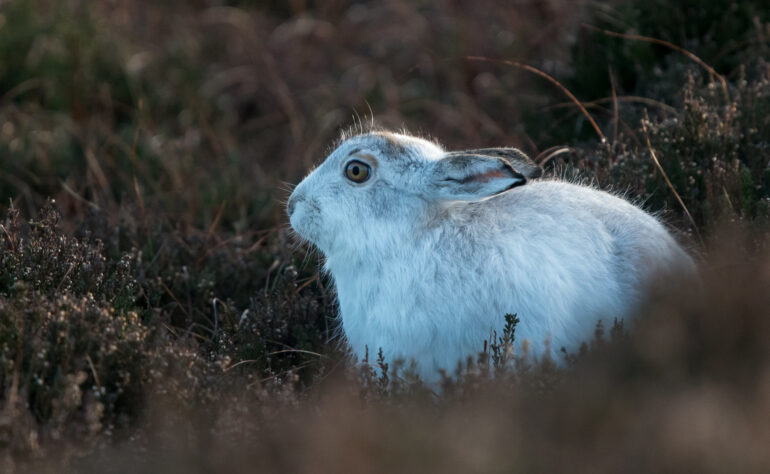New research by Manchester Metropolitan University and Queen’s University Belfast published in the journal Ecology and Evolution has warned that just 3,500 mountain hares remain in England.
The study found that the iconic species which is only found in the Peak District is holding out in areas of moorlands where their peatland habitat has been restored.
It also found that mountain hares are struggling to survive on grouse moors where peatland is often degraded by burning and heather cutting, practices performed to provide younger vegetation for game birds to eat. The deliberate culling of hares by shooting estates and risk posed by snares and traps are also believed to be contributing to declines.
Luke Steele, Executive Director of Wild Moors, said: “The research findings are extremely concerning. Mountain hares are an iconic and treasured part of the Peak District National Park and are part and parcel of what makes the protected area such an amazing palace to be. We hope this important peer-reviewed research will be taken into consideration by policy-makers.
“It’s now time for the mountain hare to be awarded safety from harm by the government designating it a protected species under the Wildlife & Countryside Act. Scotland has already made this progressive move and until England follows on our wildlife protection laws will continue to fall short.”
Wild Moors is actively supporting the protection and restoration of peatlands to ensure a healthy mosaic of upland habitats are able to support mountain hares and help tackle climate change.
The conservation organisation is also asking the government to designate mountain hares a protected species, pointing to a similar move in Scotland in 2020 which made the routine killing of the species unlawful.
Meanwhile, the Peak District National Park Authority has urged landowners and managers to voluntarily end the killing of mountain hares.
In a statement published on its website, it said: “Mountain hares are one of the most iconic and best-loved species in the Peak District. Although (re)introduced they are widely regarded as a legitimate and highly valued part of the Peak District’s wildlife, being of conservation importance and contributing to many people’s enjoyment of the National Park.
“Whilst the National Park cannot enforce against, or monitor incidents of mountain hare control, we urge landowners and managers to respect this iconic species of conservation concern within the National Park and not undertake culling.”
Ends
Notes for editors
Link to the Manchester Metropolitan University and Queen’s University Belfast research: https://onlinelibrary.wiley.com/doi/10.1002/ece3.8744
Bedson, C. P. E., Wheeler, P. M., Reid, N., Harris, W. E., Mallon, D., Caporn, S., & Preziosi, R. (2022). Highest densities of mountain hares (Lepus timidus) associated with ecologically restored bog but not grouse moorland management. Ecology and Evolution, 12, e8744. https://doi.org/10.1002/ece3.8744
Wild Moors campaigns to unlock an area of uplands the size of Greater London from grouse shooting for nature restoration by 2030. By working with communities, companies and governments to solve challenges facing the upland environment Wild Moors acts as a catalyst for creating effective and lasting change.
Extinction looms for Peak District’s iconic mountain hares
